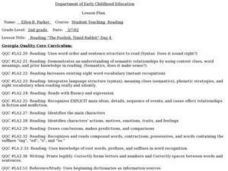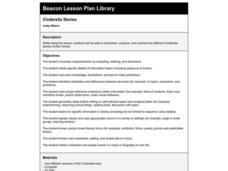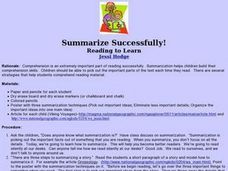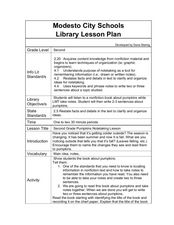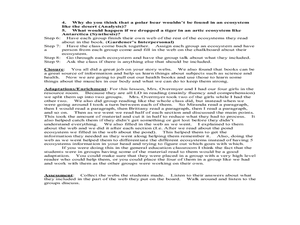Curated OER
Julius Caesar: Fate Versus Free Will
Tenth graders engage in a study that is about Julius Caesar while reading a play. The role of the main character is examined while looking for motive and tension presented by Shakespeare. They write a summary and critique of the play.
Curated OER
Creating a Science Fiction Story
As the culminating activity in a unit study of science fiction, young writers demonstrate their understanding of the genre by producing their own graphic novel. After deciding on the main elements of their story, individuals use a comic...
Curated OER
Deciphering the Mechanics of Poetry
Eighth graders analyze a variety of poems to develop the ability to recognize and explain a variety pf poetic devises.
Curated OER
Animal Communication
Young scholars use three nonfiction selections in order to investigate the concept of animal communication. They use a graphic organizer for the information as it is gathered in the reading.
Curated OER
Language Arts Exploration
While an interesting lesson plan idea involving the exploration of a story about an Asian American boy named Imduk, a teacher would need to have assess to the Scott Foresman reading program to make this work. If not, a teacher could use...
Curated OER
Tales From Around the World
Students read stories. In this culture lesson plan, students read stories from different regions around the world. Students look for each region on the map and listen for interesting cultural details in the story. Students then discuss...
Curated OER
Language Arts: Plotting Stories
Second graders read the story, "The Foolish, Timid Rabbit," as part of a unit on appearances. After reading with partners, they write their own stories that include elements about some forms of matter from their science studies. Students...
Curated OER
Cinderella Stories
Students read and compare Cinderella stories using a worksheet. They write and illustrate original tales with a twist.
Curated OER
Summarize Successfully
Students summarize nonfiction text. After reviewing the process for reading in order to summarize, students independently read a nonfiction article. They write a summary paragraph using the graphic organizer outlined by the instructor...
Curated OER
Ready, Set, Summarize
Pupils summarize nonfiction text. After reviewing the correct way to read in order to summarize, students independently read a nonfiction article. They write a summary paragraph using the three step-process outlined by the instructor...
Curated OER
Second Grade Pumpkins Note taking Lesson
Second graders read a book. In this note taking lesson, 2nd graders read a book about pumpkins and take notes together. Students write a summary about pumpkins using the information from their notes.
Curated OER
Graphic Organizers Aid Comprehension
Students create story webs to aid comprehension of ecosystems. In this reading strategies lesson, students discover the importance of organizing information while reading a nonfiction text. Students produce story webs to communicate...
Curated OER
I'm Thankful I Can Summarize
Students summarize a selected piece od nonfiction text. After reviewing the correct way to read silently, students read a nonfiction article concerning Thanksgiving. They write a summary paragraph using the five step process outlined by...
Curated OER
Living Biographies
Third graders create a multimedia slide presentation containing facts, graphics, and sounds relating to a biographical figure based on their reading of a biography or an autobiography. They present their slide presentations before the...
Curated OER
Exploring Prejudice and Text-to-Text Relationships
Tenth graders use the novel To Kill a Mockingbird to analyze relationships in society. In this literature analysis lesson, 10th graders participate in a shoe activity where they bring in one shoe belonging to someone they know and a...
Curated OER
The Stinky Cheese Man and Other Fairly Stupid Tales
Sixth graders demonstrate the ability to process and evaluate content from a variety of sources and apply comprehension skills to the material read. They organize information for practical use and design and develop an informational...
Curated OER
Very Important Points-Determine Importance
Fifth graders investigate very important points in stories. In this reading comprehension lesson, 5th graders read a story and determine what the very important points are within the story by using notes and discussing what they feel the...
Curated OER
Get to the Point!
Students summarize a selected piece of text nonfiction text. After reviewing the correct way to highlight important information, students read a nonfiction article. They write a summary paragraph using the five step process outlined by...
Curated OER
Comparing Characters Across Two Short Stories
Ninth graders listen to a read aloud of two short stories focusing on literary devices. The write about the settings and realism of the stories, and decide each main character handles the conflict he faces with nature.
Curated OER
Mapping Out Summarization
Students summarize a selected piece of text using a a six step process. After reviewing the correct way to read silently, students read a selected piece of nonfiction text. They write a summary paragraph using the six step process...
Curated OER
Short and Sweet
Students summarize nonfiction text. After reviewing the process for reading in order to summarize, students independently read a nonfiction article. They write a summary paragraph using the checklist outlined by the instructor during...
Curated OER
The Great Big Especially Beautiful Easter Egg
Students make predictions about the book The Great Big Especially Beautiful Easter Egg by doing a picture walk. In this comprehension lesson plan, students read the book, see if their predictions were right, and draw pictures of their own.
Curated OER
Night by Elie Weisel
Students read "No News from Auschwitz" and answer the study questions as an introduction to the novel. They record reactions to the essay and compare with reactions after reading "Night".
Curated OER
Adapting a Fairy Tale
Students read and prepare a new oral version of a selected fairy tale. They read and compare/contrast two fairy tales and identify the main story elements. In small groups they create a new oral version of one they fairy tales and...






